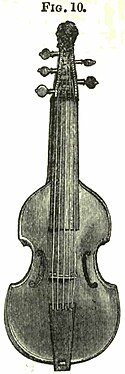About the end of the 15th century we find the viol with the distinctive features above indicated fully developed, in its three principal sizes, Discant, Tenor, and Bass, in general use. They had at first sometimes four, sometimes five, and sometimes six strings, which were tuned by fourths, a single major third being interpolated in the five and six stringed instruments, in order to preserve the same tonality in the open notes. This device was borrowed from the Lute. The fixed number of six strings, and the settled tuning by fourths with a major third in the middle, is proved to be at least as old as 1542 by a method published in that year at Venice.[1] The tuning is as follows:
| Discant. | Tenor. | Bass. |
 |
 |
 |
The relative tuning of the Viols is evidently derived from the parts of contemporary vocal music: and the early concerted music written for the Viols is always within the compass of the relative voices. It seems, in fact, to have been entirely based upon vocal music. As early as 1539 we have vocal compositions professedly adapted to be either played or sung (buone da cantare et sonare).[2]
This parallelism between the parts of vocal and stringed music explains why in early theoretical works we hear little or nothing about the Double Bass. We may however assume that it was employed as a sub-bass in octaves to the voice and Bass Viol. Strung with three, four, five, and even six strings, the lowest would by analogy be tuned a fourth lower than those of the Bass Viol, as at (a); and this is in fact the tuning of the modern Double Bass. The tuning for completely strung instruments was probably as at (b), but the highest strings would be ineffective, and liable to break, and they could have been of little use in playing a sub-bass:
| (a) | (b) |
 |
 |
and as the pressure of useless strings impairs the resonance of the instrument, it may be assumed that the upper strings came to be gradually abandoned. The trio of viols, tuned as prescribed by the 'Regola Rubertina' of 1542, continued in use unaltered for a century and a half as the basis of chamber-music: for Playford's 'Introduction to the Skill of Musick' gives the same tuning without alteration. We may therefore take the duration of the school of pure six-stringed viol music as about a hundred and fifty years (1550–1700). During the latter part of this period the Violin and Tenor Violin came steadily into use for orchestral purposes in substitution for the Treble and Tenor Viols, and the invention of the Violoncello or Bass Violin completed the substitution of the new model for the old. The trio of viols was in fact rather a theoretical than a practical musical apparatus: and its two highest members had but little significance apart from the rest. The Treble or Discant Viol, feeble and delicate in tone, though employed in concerted music, never took the place of the more powerful Rebec and Geige, which continued in popular use until they were ultimately driven from the field by the Violin. The Tenor Viol laboured under a great disadvantage. Being too large and too clumsy to be played fiddlewise, it became the practice to rest the lower part of the instrument on the knee, and its shoulder upon the arm, the left hand being elevated at the height of the head. It was then bowed underhand, the bow passing obliquely over the strings. This difficulty must have tended to check its musical usefulness: and as the lowest string of both the Discant and Tenor Viol was little used, it was at length omitted, and makers were thus enabled to construct Tenor Viols of more manageable size. The German and French Treble and Tenor Viols of late manufacture have only five strings, the lowest in each, as in the Violin and Tenor, being G and C respectively. The Treble and Tenor Viols thus gradually approximated in size and tuning to the Violin and Tenor, by which they were ultimately effaced. The five-stringed Treble Viol survived longest in France, where it was called 'Quinton' or 'Pardessus de Viole': and from the very numerous specimens which were sent forth in the last century from the workshops of Guersan and other Parisian makers, there can be no doubt that it was a fashionable instrument, in fact probably a musical toy for ladies of quality.  The stop being an inch shorter than that of the Violin, and the tuning by fourths and a third entirely obviating the necessity of employing the fourth finger, it is easily played by small and comparatively unpractised hands. The back and ribs of Guersan's Quintons are usually built up of parallel staves of sycamore and cedar, a method which not only makes the tone extremely soft and resonant, but combined with fine finish and elegantly carved scrolls gives them a most picturesque appearance. The illustration is from a specimen in the writer's possession.
The stop being an inch shorter than that of the Violin, and the tuning by fourths and a third entirely obviating the necessity of employing the fourth finger, it is easily played by small and comparatively unpractised hands. The back and ribs of Guersan's Quintons are usually built up of parallel staves of sycamore and cedar, a method which not only makes the tone extremely soft and resonant, but combined with fine finish and elegantly carved scrolls gives them a most picturesque appearance. The illustration is from a specimen in the writer's possession.
The development of the Viola d'Amore, which is briefly described below, probably prevented the use of the common Tenor Viol, without sympathetic strings, as a solo instrument. Built large
